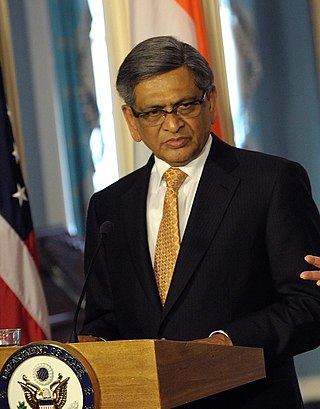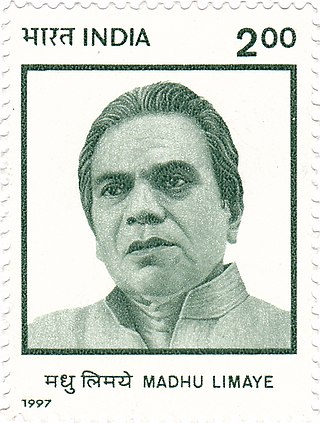
The Communist Party of India (CPI) is the oldest Marxist–Leninist communist party in India and one of the nine national parties in the country. The CPI was founded in modern-day Kanpur on 26 December 1925.
Lal Nishan Party (Leninvadi) is a communist political party in the Indian state of Maharashtra. LNP(L) was formed a splinter group of Lal Nishan Party in 1988. LNP(L) was critical to that LNP had gotten closer to the Indian National Congress and the Perestroika.

Somanahalli Mallaiah Krishna is an Indian politician who served as Minister of External Affairs of India from 2009 to October 2012. He was the 16th Chief Minister of Karnataka from 1999 to 2004 and the 19th Governor of Maharashtra from 2004 to 2008. SM Krishna had served as the Speaker of the Karnataka Vidhan Sabha from December 1989 to January 1993. He was also a member of Lok Sabha and Rajya Sabha at various times from 1971 to 2014.

The 14th Lok Sabha was convened after the 2004 Indian general election held in four phases during 20 April – 10 May 2004, which led to the formation of first Manmohan Singh ministry (2004–2009). Indian National Congress-led United Progressive Alliance won 62 more seats than previous 13th Lok Sabha. The Lok Sabha is the lower house in the Parliament of India. 8 sitting members from Rajya Sabha, the Upper House of Indian Parliament, were elected to 14th Lok Sabha after the 2004 Indian general election.

All India Kisan Sabha, is the peasant or farmers' wing of the Communist Party of India, an important peasant movement formed by Sahajanand Saraswati in 1936.
Although India is a parliamentary democracy, the country's politics has become dynastic or with high level of nepotism, possibly due to the absence of party organizations, independent civil-society associations which mobilize support for a party, or centralized financing of elections. The dynastic phenomenon is present at the national, state, regional, and district level. The Nehru–Gandhi family has produced three Indian prime ministers, and family members have largely led the Congress party since 1978. The ruling Bharatiya Janata Party (BJP) also has several senior dynastic leaders. In addition to the major national parties, other national and regional parties such as Shiromani Akali Dal, Shiv Sena, Samajwadi Party, Rashtriya Janata Dal, Janata Dal Secular, Jharkhand Mukti Morcha, Dravida Munnetra Kazhagam, Kerala Congress, Jammu & Kashmir National Conference, Indian Union Muslim League, AIMIM, and the Nationalist Congress Party are all dominated by families, mostly those of the party founders.

Madhu Limaye, full name: Madhukar Ramchandra Limaye, was an Indian socialist essayist and activist, particularly active in the 1970s. A follower of Ram Manohar Lohia and a fellow-traveller of George Fernandes, he was active in the Janata government that gained power at the Centre following the Emergency. He, with Raj Narain and Krishan Kant was also responsible for the collapse of the Morarji Desai-led Janata government installed by that coalition, by insisting that no member of the Janata Party could simultaneously be a member of an alternative social or political organisation. This attack on dual membership was directed specifically at members of the Janata Party who had been members of the Jan Sangh, and continued to be members of the right-wing Rashtriya Swayamsevak Sangh (RSS), the Jan Sangh's ideological parent. The issue led to fall of the Janata government in 1979, and the destruction of the Janata coalition.

Chandikadas Amritrao Deshmukh, better known as Nanaji Deshmukh, was a social reformer and politician from India. He worked in the fields of education, health, and rural self-reliance. He was posthumously awarded the Bharat Ratna, India's highest civilian award in 2019 by Government of India. He was a leader of the Bharatiya Jana Sangh and also a member of the Rajya Sabha.

Indrajit Gupta was an Indian politician who belonged to the Communist Party of India (CPI). From 1996 to 1998, he served as Union Home Minister in the United Front governments of prime ministers H. D. Deve Gowda and I. K. Gujral. That was a dramatic reversal of roles, as the home ministry had, since independence in 1947, banned the CPI thrice, with many of its members, including Gupta, being sent to prison or pushed underground for long stretches. He was the longest-serving member having been elected eleven times to the Lok Sabha the lower house of Indian Parliament.He suffered his only electoral reverse when he lost to Ashok Krishna Dutt in 1977 after the CPI supported Emergency.

Sir Raghunath Purushottam Paranjpye was the first Indian to achieve the coveted title of Senior Wrangler at the University of Cambridge, and became a university administrator and Indian ambassador.
Gangadhar Appa Burande was an Indian politician.
Keshavrao Marutrao Jedhe (Deshmukh) was an Indian independence activist and politician from Pune. He served as a leading figure in the Indian National Congress, and in the Samyukta Maharashtra movement during independence. The famous Swargate chowk in Pune is named after him.
Dattatraya Kashinath Kunte, also known as Nanasaheb Kunte was an Indian independence activist, a former Member of the Bombay Legislative Assembly and the 4th Lok Sabha. He was born at Alibag in 1908 and died in Mumbai in 1991.

Shivajirao Girdhar Patil was an Indian social activist and politician from the state of Maharashtra. He began his social activism at an early age when he participated in the Indian independence movement. Post-independence, he was associated with various political parties and had been member of the Maharashtra Legislative Council, Maharashtra Legislative Assembly and even the Rajya Sabha for one term. In 2013, he was presented with the Padma Bhushan, India's third highest civilian award. He was the father of Indian film actress Smita Patil.
The Kamgar Kisan Paksha was a political party in Bombay State, India. The party was formed by a group of dissidents from the Peasants and Workers Party of India in November 1951, just before the 1951-1952 elections. The founders of Kamgar Kisan Paksha wanted closer cooperation with the Communist Party of India. Its main leaders were Nana Patil, Datta Deshmukh and D.S. Wagh.
Drupad Borgohain was an Indian politician. He was a veteran leader of the left-wing in the Assam state. As of 2014 he was the secretary of the Assam State Council of the Communist Party of India (CPI), a position he held since 1987. As of 2010 he served as president of Assam state council of All India Kisan Sabha.
Although a parliamentary democracy, Indian politics has increasing become dynastic, possibly due to the absence of a party organization, independent civil society associations that mobilize support for the party, and centralized financing of elections. Family members have also led the Congress party for most of the period since 1978 when Indira Gandhi floated the then Congress(I) faction of the party. It also is fairly common also in many political parties in Maharashtra. The dynastic phenomenon is seen from national level down to district level and even village level.The three-tier structure of Panchayati Raj created in the 1960s also helped to create and consolidate this phenomenon in rural areas. Apart from government,political families also control cooperative institutions, mainly cooperative sugar factories and district cooperative banks in the state. The ruling Bharatiya Janata Party also features several senior leaders who are dynasts. In Maharashtra, the NCP has particularly high level of dynasticism.
Ganpatrao Deshmukh was an Indian politician. He was in office for 54 years. He was called "Abasaheb" by the people with love and affection. He was also called "Bhai" by peasants and workers.

In 1964 a major split occurred in the Communist Party of India. The split was the culmination of decades of tensions and factional infighting. When India became independent in 1947, differences arose of how to adapt to the new situation. As relations between the Nehru government and the Soviet Union improved, a faction that sought cooperation with the dominant Indian National Congress emerged within CPI. This tendency was led by S.A. Dange, whose role in the party hierarchy became increasingly controversial. When the Sino-Indian War broke out in 1962 Dange's opponents within CPI were jailed, but when they were released they sought to challenge his leadership. In 1964 the party was finally divided into two, with the left faction forming the Communist Party of India (Marxist). The split had a lot of regional variations. It also impacted other organizations, such as trade union and peasant movements. The split has been studied extensively by scholars, who have sought to analyze the various domestic and international factors involved.
Udhavrao Sahebrao Patil (1920-1984) was an Indian politician. He was the leader of the Peasants and Workers Party of India (PWP). He was elected to the Lok Sabha, the lower house of the Parliament of India as a member of the Peasants and Workers Party of India.










